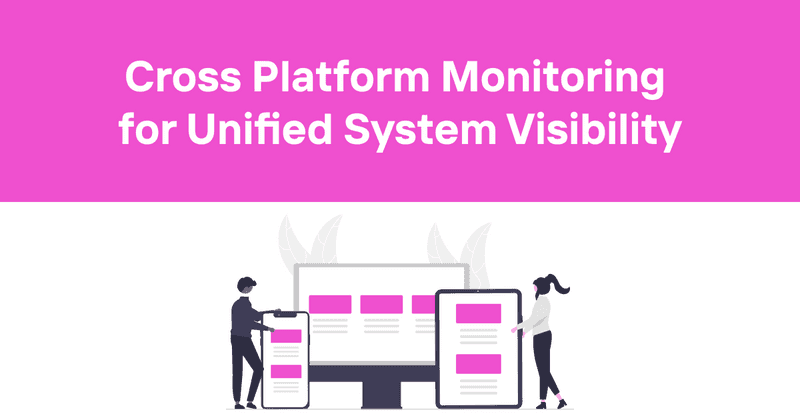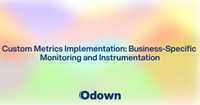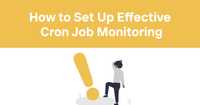Cross Platform Monitoring for Unified System Visibility
In today's interconnected world, applications and services run across a multitude of platforms. From Windows servers to Linux containers, from iOS to Android devices, and from on-premises infrastructure to various cloud providers—managing this diverse ecosystem presents significant challenges for development and operations teams.
Cross platform monitoring offers a solution by providing visibility across your entire technological landscape. But implementing an effective monitoring strategy that works seamlessly across different operating systems, cloud environments, and device types requires careful planning and the right tools.
Let's explore how to build a robust cross platform monitoring approach that keeps your systems running smoothly, no matter where they're deployed.
Table of Contents
- What is Cross Platform Monitoring?
- Why Cross Platform Monitoring Matters
- Common Challenges in Multi-Platform Environments
- Key Components of Effective Cross Platform Monitoring
- Monitoring Across Operating Systems
- Cloud Platform Monitoring Considerations
- Mobile and IoT Device Monitoring
- Implementing a Cross Platform Monitoring Strategy
- Unified Dashboards and Reporting
- Security Considerations Across Platforms
- Cross Platform Alerting Best Practices
- The Future of Cross Platform Monitoring
- Benefits of Using Odown for Cross Platform Monitoring
What is Cross Platform Monitoring?
Cross platform monitoring refers to the practice of tracking, analyzing, and managing the performance, availability, and health of applications and infrastructure that span multiple operating systems, cloud providers, and device types. Unlike traditional monitoring approaches that might focus on a single technology stack, cross platform monitoring provides a unified view across your entire heterogeneous environment.
This approach allows teams to track metrics, logs, and traces from Windows servers, Linux machines, cloud services, containers, and mobile applications—all from a single pane of glass. The goal is to eliminate monitoring blind spots that occur when different platforms require different tools and approaches.
Why Cross Platform Monitoring Matters
The complexity of modern technology stacks makes cross platform monitoring not just helpful but essential. Here's why:
- Distributed Applications: Modern applications are rarely contained within a single environment. Your database might run on Linux, your application servers on Windows, and your front-end could be hosted in a managed Kubernetes service.
- Mixed Infrastructure: Many organizations maintain hybrid environments with on-premises servers alongside cloud resources, or multi-cloud strategies that leverage several providers simultaneously.
- Diverse User Devices: Your users access applications from Windows PCs, Macs, Android phones, iPhones, tablets, and more—each with their own potential issues.
- Consistent Experience: Users expect your service to work the same way regardless of where or how they access it.
Without effective cross platform monitoring, troubleshooting becomes fragmented, time-consuming, and less effective. You might miss critical correlations between issues on different platforms or struggle to identify the root cause of problems that span multiple systems.
Common Challenges in Multi-Platform Environments
Monitoring across different platforms comes with unique hurdles:
- Inconsistent Metrics: Each platform may report similar concepts in different ways. CPU utilization on Windows isn't measured identically to Linux or a cloud provider's compute service.
- Platform-Specific Issues: Some problems only manifest on particular platforms. A memory leak might only appear in your iOS app but not on Android.
- Agent Compatibility: Monitoring agents that work flawlessly on one operating system might cause performance issues on another.
- Authentication Differences: Each platform may have different security models and authentication requirements for monitoring tools.
- Data Silos: When using multiple monitoring tools for different platforms, critical information often becomes isolated in separate systems.
These challenges highlight why a thoughtful, integrated approach to cross platform monitoring is so important for maintaining reliable services.
Key Components of Effective Cross Platform Monitoring
A comprehensive cross platform monitoring solution should include:
-
Infrastructure Monitoring: Tracking the health and performance of servers, networks, and storage across all environments.
-
Application Performance Monitoring (APM): Understanding how your applications behave across different operating systems and devices.
-
End-User Experience Monitoring: Measuring how users experience your application on various platforms and devices.
-
Availability Monitoring: Confirming that your services are accessible from different platforms and locations.
-
Log Management: Centralizing and correlating logs from diverse systems.
-
Alerting and Notification: Providing timely, actionable alerts when issues arise on any platform.
-
Anomaly Detection: Identifying unusual patterns that might indicate problems across your environment.
The most effective solutions integrate these components to provide a holistic view of your technology ecosystem.
Monitoring Across Operating Systems
Different operating systems present unique monitoring challenges:
Windows Monitoring
Windows environments typically offer:
- Windows Management Instrumentation (WMI) for collecting system data
- Performance Counters for tracking resource usage
- Event Logs for system and application events
When monitoring Windows, pay attention to:
- IIS performance if running web applications
- .NET Framework metrics
- Windows Service health
- Registry changes
Linux Monitoring
Linux systems provide:
- /proc filesystem for accessing system information
- sysstat tools for performance statistics
- systemd-journald or syslog for logging
Key focus areas include:
- Process resource consumption
- File system usage and I/O
- Network connections
- System load averages
macOS Monitoring
For macOS environments:
- Activity Monitor data
- System logs via Console
- DTrace for advanced diagnostics
Cross-OS Compatibility
The ideal monitoring solution should:
- Use lightweight, compatible agents for each OS
- Normalize metrics across platforms for meaningful comparisons
- Support native logging formats from each system
- Provide unified alerting regardless of the source platform
This table summarizes key differences in monitoring approaches across operating systems:
| Feature | Windows | Linux | macOS |
|---|---|---|---|
| Performance Data | Performance Counters, WMI | /proc, sysstat | Activity Monitor APIs |
| Logging System | Event Logs | syslog/journald | unified logging |
| Process Inspection | Task Manager APIs | procfs | Activity Monitor APIs |
| Default Metrics | % Processor Time, Memory | Load Average, Memory | CPU Load, Memory Pressure |
| Filesystem Monitoring | NTFS | ext4, xfs, btrfs | APFS, HFS+ |
Cloud Platform Monitoring Considerations
Modern applications increasingly span multiple cloud providers, each with their own monitoring approaches:
AWS Monitoring
Amazon Web Services provides CloudWatch as its primary monitoring service. When implementing cross platform monitoring with AWS:
- Use CloudWatch metrics for AWS-specific services
- Consider CloudWatch Logs for centralized logging
- Leverage CloudWatch Events for event-driven monitoring
- Implement X-Ray for distributed tracing
Azure Monitoring
Microsoft Azure offers Azure Monitor and Application Insights:
- Azure Monitor for infrastructure and platform services
- Application Insights for application performance
- Log Analytics for log collection and analysis
- Azure Monitor for Containers for Kubernetes monitoring
Google Cloud Monitoring
Google Cloud's monitoring stack includes:
- Cloud Monitoring for metrics collection
- Cloud Logging for log management
- Cloud Trace for distributed tracing
- Cloud Profiler for code performance analysis
Multi-Cloud Strategies
For environments spanning multiple cloud providers:
- Implement a cloud-agnostic monitoring solution that normalizes metrics
- Use consistent tagging across providers for better organization
- Consider service mesh solutions for monitoring multi-cloud applications
- Look for tools that support all your cloud providers natively
The challenge here is bringing together the native monitoring capabilities of each cloud with your existing tools. Many teams adopt specialized cross platform monitoring solutions that can ingest data from multiple clouds while providing a unified experience.
Mobile and IoT Device Monitoring
Extending monitoring to mobile apps and IoT devices introduces additional complexity:
Mobile Application Monitoring
For mobile apps running on iOS and Android:
- Track app crashes and errors specific to each platform
- Monitor application launch times and UI responsiveness
- Analyze battery and network usage
- Implement user journey tracking across platforms
IoT Device Monitoring
IoT environments may include devices running specialized real-time operating systems:
- Monitor device connectivity and heartbeats
- Track battery levels for power-constrained devices
- Measure data transmission rates and reliability
- Detect anomalous behavior that might indicate security issues
The key with both mobile and IoT monitoring is balancing the need for detailed telemetry with bandwidth and battery constraints. Cross platform monitoring tools need to use efficient protocols and batching techniques to minimize their impact on device performance.
Implementing a Cross Platform Monitoring Strategy
To build an effective cross platform monitoring approach:
-
Start with clear objectives: Define what success looks like for your monitoring program across platforms.
-
Create a platform inventory: Document all the different operating systems, cloud services, and device types in your environment.
-
Identify critical metrics: Determine which metrics and logs are essential across all platforms, and which are platform-specific.
-
Choose compatible tools: Select monitoring solutions that support all your platforms or can be integrated together.
-
Standardize where possible: Use consistent naming conventions, tags, and metadata across platforms.
-
Implement gradually: Start with your most critical systems and expand coverage methodically.
-
Train your team: Ensure staff understands how to interpret data from different platforms.
-
Review and refine: Regularly assess the effectiveness of your monitoring approach and adjust as needed.
Remember that cross platform monitoring is an ongoing process, not a one-time implementation. Your strategy should evolve as your technology stack changes.
Unified Dashboards and Reporting
One of the biggest benefits of cross platform monitoring is the ability to create unified views of your entire environment. Effective dashboards should:
- Present normalized metrics from different platforms for fair comparisons
- Allow drilling down from high-level overviews to platform-specific details
- Support custom views for different team roles (development, operations, management)
- Enable correlation between events on different platforms
- Provide historical context for current performance
Some organizations create custom dashboards for specific use cases, such as:
- Service health dashboards showing end-to-end availability across platforms
- Customer journey maps tracking user experience across web and mobile
- Infrastructure cost dashboards comparing resource efficiency across cloud providers
- Security posture views highlighting vulnerabilities across all platforms
The goal is to break down data silos and create a common operational picture for all stakeholders, regardless of the underlying technology.
Security Considerations Across Platforms
Security monitoring presents unique cross platform challenges:
- Different vulnerability profiles: Each platform has its own set of potential security issues.
- Varying security controls: Authentication, authorization, and data protection mechanisms differ across systems.
- Platform-specific compliance requirements: Regulatory needs may vary by platform or location.
- Inconsistent logging: Security events may be formatted differently across systems.
To address these challenges:
- Implement centralized security information and event management (SIEM)
- Normalize security events from different sources
- Correlate events across platforms to detect sophisticated attacks
- Maintain platform-specific security baselines
- Automate security scanning across all environments
Cross platform security monitoring is particularly valuable for detecting lateral movement between systems and identifying attack patterns that might be missed when looking at platforms in isolation.
Cross Platform Alerting Best Practices
Alert fatigue is a common issue in complex environments. To create effective alerting across platforms:
- Normalize thresholds: Adjust alert thresholds to account for platform differences.
- Implement intelligent grouping: Correlate related alerts from different platforms.
- Provide context: Include platform-specific troubleshooting guidance with alerts.
- Route appropriately: Direct alerts to teams with the right expertise for each platform.
- Reduce noise: Filter out transient issues that self-resolve.
- Enable cross-platform correlation: Alert on patterns spanning multiple systems.
The most sophisticated monitoring systems use machine learning to establish baseline behavior for each platform and alert only on significant deviations, reducing false positives while catching real issues.
The Future of Cross Platform Monitoring
Several trends are shaping the evolution of cross platform monitoring:
- AIOps and machine learning are automating the analysis of data across platforms, identifying patterns humans might miss.
- OpenTelemetry is emerging as a standard for collecting telemetry data regardless of source platform.
- Serverless monitoring is addressing the challenges of monitoring highly ephemeral compute resources.
- Shift-left monitoring integrates observability into the development process across all platforms.
- Real user monitoring is becoming more sophisticated in tracking user journeys across web, mobile, and other interfaces.
As environments become more complex and distributed, cross platform monitoring will continue to grow in importance and capability.
Benefits of Using Odown for Cross Platform Monitoring
Odown provides an elegant solution for organizations needing robust cross platform monitoring capabilities:
Unified Monitoring Across Platforms
Odown excels at providing a consistent monitoring experience regardless of your technology stack. Whether you're monitoring Windows servers, Linux containers, cloud services, or web applications, Odown's platform-agnostic approach eliminates blind spots in your monitoring coverage.
Comprehensive Uptime Monitoring
With Odown, you can monitor the availability of services across all platforms from multiple geographic locations. This ensures you're aware of platform-specific outages or regional issues before they impact your users.
SSL Certificate Monitoring
Security certificates are critical across all platforms. Odown's SSL certificate monitoring capabilities track certificate expiration, configuration issues, and security vulnerabilities across your entire certificate inventory, regardless of platform.
Public Status Pages
Odown's public status pages provide transparent communication with your users about the health of your services across different platforms. Instead of maintaining separate status indicators for different components, you can present a unified view of service health.
Intelligent Alerting
By understanding the context of different platforms, Odown reduces alert noise while ensuring critical issues get immediate attention. Alerts are enriched with platform-specific details, making troubleshooting more efficient.
API-First Approach
Odown's API-first design makes it easy to integrate monitoring into your existing tools and workflows across platforms. This flexibility allows teams to work with their preferred tools while maintaining a consolidated view of system health.
Simple Deployment
Unlike many monitoring solutions that require complex agent configurations for different platforms, Odown offers straightforward implementation across diverse environments. This reduces the operational overhead of maintaining your monitoring infrastructure.
By choosing Odown for cross platform monitoring, organizations can maintain visibility across their entire technology landscape while reducing the complexity and cost associated with managing multiple monitoring solutions.
Cross platform monitoring is no longer a luxury—it's a necessity for maintaining reliable, secure, and performant systems in today's diverse technology environments. With the right approach and tools like Odown, you can bridge the gaps between platforms and ensure consistent visibility across your entire digital ecosystem.



